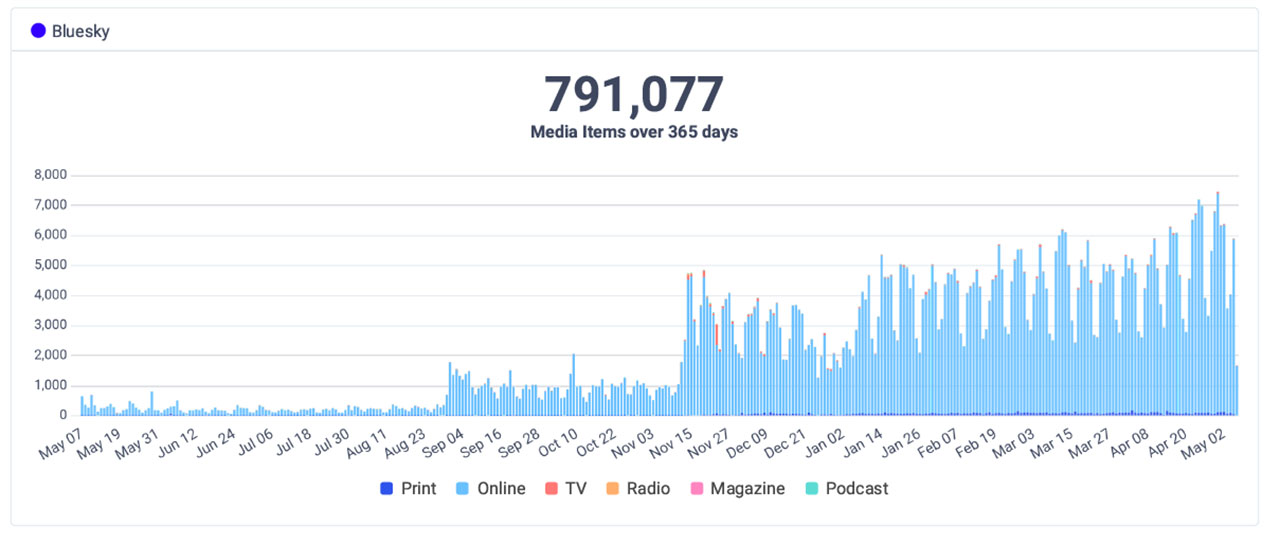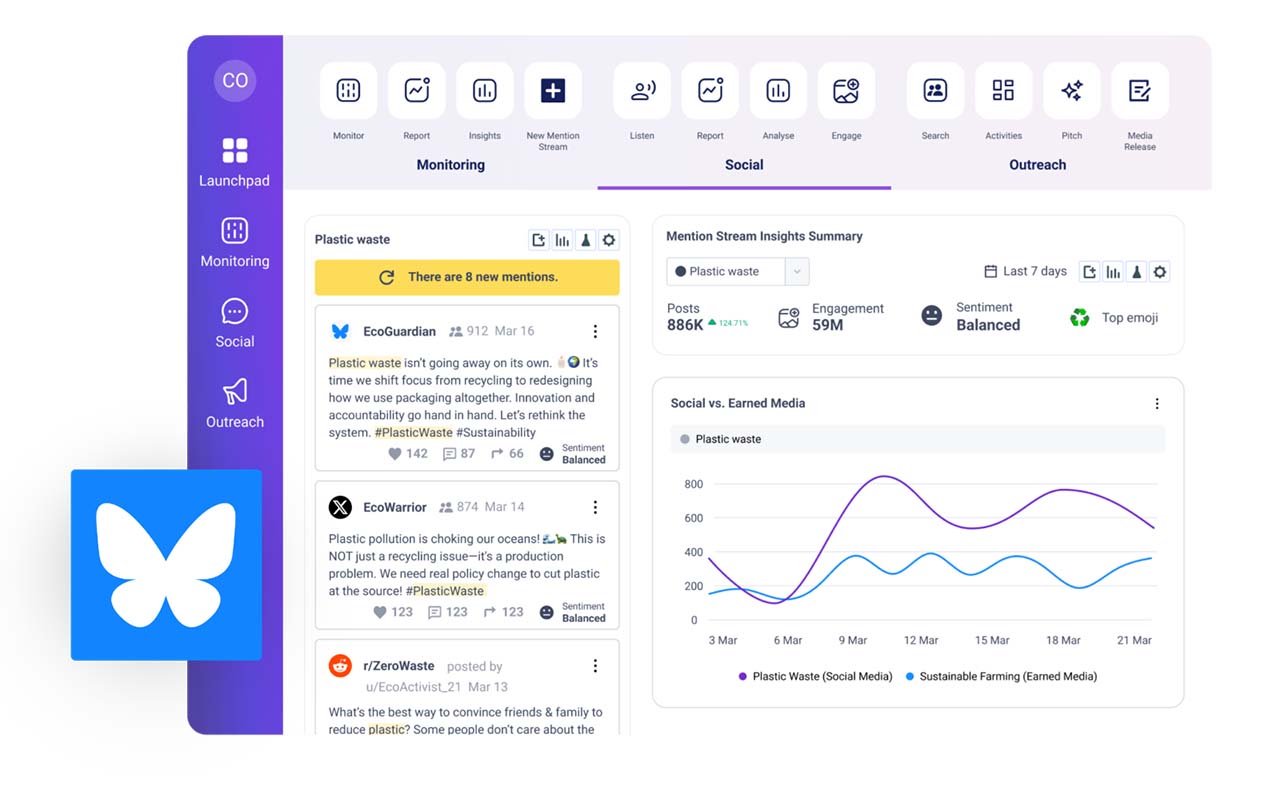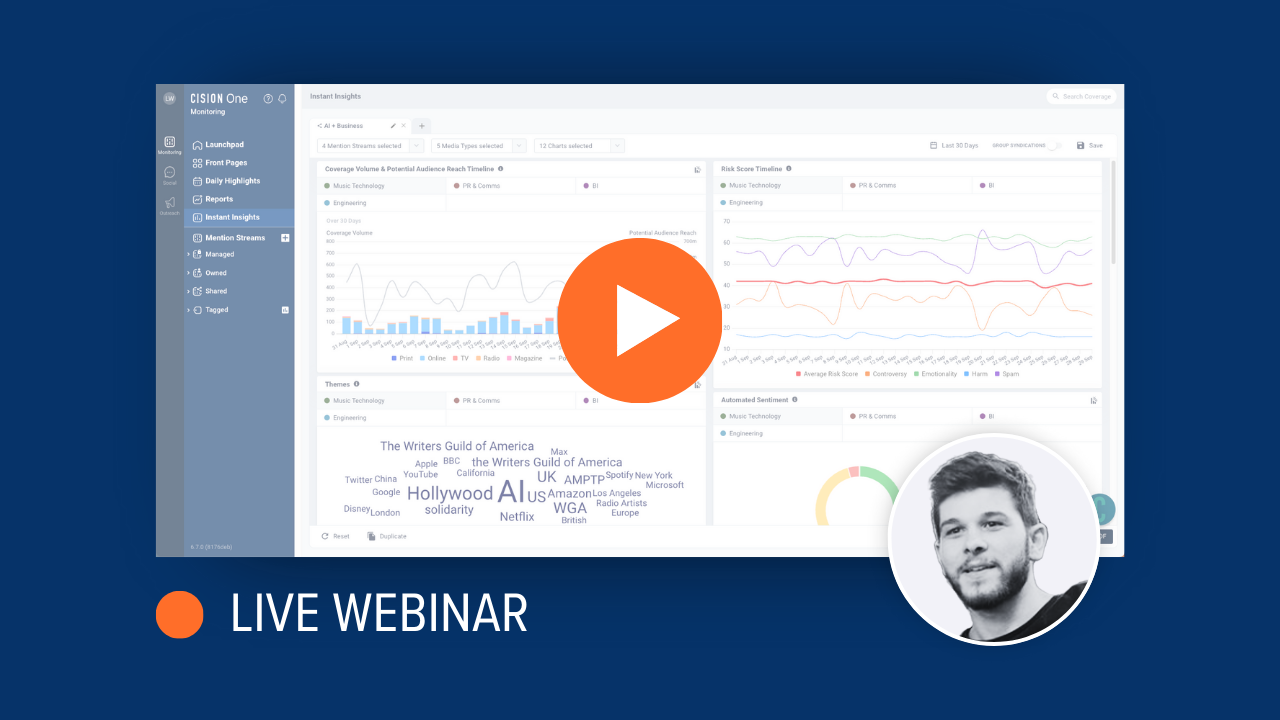Social media platforms are emerging all the time, but over the last 12 months, few have grown as rapidly as Bluesky.
A new social media platform is always exciting as it presents another channel to get your message out in the world to new audiences, but is there a need for BlueSky for PR and comms purposes? If you’re looking for another channel to follow and engage with journalists, then the answer is undoubtedly yes.
According to the 2025 State of the Media Report, 27% of journalists in North America said it’s the social media platform they use most frequently for professional purposes, making it more popular than more established social networks like Reddit (16%) and TikTok (14%).
We’re going to dive into what Bluesky is, why users are flocking to the platform, and why Bluesky for PR professionals is an avenue worth pursuing.
What is Bluesky?
Bluesky is a social media platform where users can post, reply, reshare, and send direct messages to each other on an interface that’s reminiscent of X and the Meta-owned Threads.
In terms of layout, by default you’ll find a vertical feed showing posts in chronological order of accounts you’re following with further options of a “discover” timeline to find new accounts and options to view content feeds you curate. Bluesky can be accessed via desktop, iOS, macOS, and Android devices.
Now for the complicated technical stuff. Unlike other social platforms, Bluesky is decentralized and built on a proprietary open source AT Protocol. This means users have more control over their experience and can host their data on servers other than those owned by the company (though admittedly most opt for ".bsky.social" usernames).
The Bluesky website describes the platform as "social media as it should be. Find your community among millions of users, unleash your creativity, and have some fun again.”
Who Owns Bluesky?
There’s a reason why Bluesky, with its blue butterfly icon, looks and feels a lot like the pre-X Twitter of yesteryear.
It began in 2019 as a research project within Twitter before spinning off into its own entity – Bluesky Social PBC (a Public Benefit Company that aims to have a positive impact on society rather than focus on maximizing shareholder value) – in 2021. It launched as an invite-only service in February 2023 and opened registrations in February 2024.
Bluesky is the brainchild of Twitter co-founder Jack Dorsey, who remained on its board until May 2024. Now, the company is headed by CEO Jay Graber and headquartered in Seattle.
Why has Bluesky Grown So Quickly?
As of May 2025, Bluesky has surpassed 35 million total registered users, surging from 14.5 million in October 2024.
The similar decentralized social network Mastadon initially gained traction, while Threads’s integration with Instagram has given the text-driven platform a head-start with over 350 million monthly active users.
Though Threads is much closer to X in terms of user volume, 2025 State of the Media stats show that its usage with journalists in North America trails Bluesky (10% use Threads for work versus 27% Bluesky).
Bluesky has gradually been growing as Twitter’s evolution into X has prompted users to search for alternative platforms with comparable functionality. According to research from Similarweb and The Guardian, Bluesky’s active daily users saw steady growth after the 2024 U.S. election, while X has declined.
Media coverage and interest in Bluesky has skyrocketed, too. The below CisionOne chart shows just how mentions have exploded over a 365-day period form May 2024 to May 2025.

How is Bluesky Different From Other Social Media Platforms?
As Bluesky has grown, it has become an increasingly viable platform for journalists, brands, and influencers to gather and discuss news, trends, and topical interests.
Yet there are numerous ways Bluesky is different from other social networks. Many of the below points will be familiar to social media users, however several are unique to Bluesky.
- Chronological timeline: If you want to remove the noise of social media algorithms then Bluesky has a straightforward feed that allows you to view posts in true chronological order without them throwing up unconnected replies or interactions.
- Custom algorithm-driven feeds: Within Bluesky's "Feeds" you can subscribe to custom algorithmic channels created by other users. You can even create your own custom feed with specific parameters. E.g. the PR and Comms feed brings together relevant posts on this specific topic.
- Starter packs: These are collections of user or brand accounts bundled by theme or interest that you can follow all at once. They're ideal for new users who want to quickly populate their timeline with quality content on specific topics without having to discover accounts one by one. For PR pros working, say, in the technology sector, there are plenty of tech starter packs that will let you follow journalists, brands, and thought leaders in that industry.
- User lists: Beyond just following individuals, Bluesky allows you to create, share, and subscribe to lists of users organized by topic or interest. Unlike some platforms where lists are private or difficult to share, Bluesky makes lists a central feature for content discovery and community building.
- Content labelling: Bluesky offers a system that allows users to mark their content appropriately. This creates a more nuanced approach to content moderation where users have greater control over what they see, rather than relying solely on platform-wide policies.
- Anti-toxicity features: As well as block and mute functions for unwanted accounts, Bluesky prioritizes trust and safety through its anti-toxicity features. These allow users to detach themselves from mentions in quote posts, hide replies, and remove yourself form starter packs or curated lists.
- No advertisements: As of May 2025, Bluesky doesn't have advertisements in its feeds, creating a cleaner, faster user experience focused entirely on content from the people and communities you follow.
Should Brands Join Bluesky?
In short: yes. As more journalists, consumers, and influential voices begin to migrate to the platform, this becomes another avenue to track conversations and trends relevant to your industry or brand. If PR teams aren’t actively listening across these spaces, you risk missing critical narratives that could shape public perception.
PR teams are also under increasing pressure to make sense of the vast number of social conversations happening. They need to be aware of any crises that may be emerging – and deliver insights that inform broader business decisions. With leadership teams more concerned than ever about the impact of negative social media conversations, PR pros can’t afford to neglect Bluesky completely.
Meghan Meeker, director of social media at Brandwatch and Cision, says of Bluesky's emergence: "When a new social media platform comes into the mix, I always ask myself first about my and my team's capacity. If we don't have the ability to make consistent content on that platform, maybe we should stick with what is already working. But conversely Bluesky is a rapidly growing platform that might be a great fit for your brand."
6 PR Starter Tips for Brands on Bluesky
We know that social media community management is a time-consuming business and adding another feed to your team’s workload might not be feasible. However, even if you’re not planning to actively post on Bluesky in the same way you are on LinkedIn or Instagram, here are some initial tips to help you get started.
1. Claim your name
Your social media team may well have done this already, but check in with them to make sure you’ve claimed your brand account name (and any related product/service names of value). The last thing you want is cyber squatters sitting on your account and having to fight them to claim it back. Even if you don't plan to be active on Bluesky immediately, it's a good idea to make sure you own your handle.
2. Get Verified
Trust means everything in PR and comms. Fortunately, Bluesky can help with blue-check verification for added authenticity. Users can self-verify by setting their web domain as their account name, while brands on Bluesky can set themselves as trusted verifiers then issue blue checks to their employees or representatives.
3. Follow Relevant Accounts
Once you have an account set up, ensure you’re following any key accounts like members of your C-suite, employees, and any journalists, feeds, and users related to your sector. Remember, people won’t find you organically, so don’t be afraid to join conversations relevant to your brand so you’ll be seen and discovered.
4. Experiment with Content Posts
A similarity to X and Threads means that if you’re already creating content for these platforms, you may be able to make small adjustments and repurpose it for Bluesky. This is a quick and resource-light way of testing the waters with the platform and seeing if there’s scope for further engagement.
5. Monitor Your Mentions
Is your brand being talked about on Bluesky? You can track this manually, or utilize a tool like CisionOne to gather this data quickly. Our media monitoring platform has unrestricted listening across Bluesky, giving PR teams real-time visibility into the conversations shaping brand sentiment, emerging trends, and the key voices driving discussions.
6. Evaluate Impact
The only way to know if you’re being talked about on Bluesky is if you’re on the platform. Similarly, by posting content, you’ll be able to learn if you’re attracting new followers and if it moves the needle in terms of referral traffic or conversions. Set yourself a consistent posting schedule for a fixed timeframe then evaluate your next steps once you have a relevant set of metrics.

Meeker has this advice for brands exploring Bluesky: “I would do some experimentation after securing my brand's handle. Join conversations, follow industry leaders, and see how others move around the space. Social media is constantly evolving and takes some trial and error – so give a new platform some time to see if it works for your brand.
“If it does, try to move efforts around to be able to create consistent and quality content there. And if it doesn't, go back to the old formula.”
Final Thoughts on Bluesky for PR
While Bluesky may require extra resource when it comes to community management, it’s worth remembering that the brands who jump on the platform early are giving themselves more time to experiment and figure out how to engage with audiences. Plus, by using the tips above, the initial effort will be low but with the potential for impact.
When it comes to social monitoring and content creation, Bluesky may not be your major focus right now but there’s clearly value in integrating it into a broader social strategy. As the platform continues to grow – particularly among journalists – maintaining awareness of relevant conversations is key, even if your brand's active participation is limited. Start small, gather insights, then adjust your approach as the platform evolves and its relevance to your brand and industry become clearer.
Find out how CisionOne Social can help you monitor the Bluesky conversations that matter, speak to one of our experts.
Most Recent Posts
Cision Resources
-
E-books and Guides
Comprehensive how-to guides on strategy and tactics
-
Case Studies
What are other brands doing – and how can we learn from them?
About Simon Reynolds
Simon is the Senior Content Marketing Manager at Cision. He worked as a journalist for more than a decade, writing on staff and freelance for Hearst, Dennis, Future and Autovia titles before joining Cision in 2022.
Learn More. Do More. demo new
PR Tips, Case Studies, and Product Updates

[On-Demand Webinar] The Next Generation of Media Intelligence: From Gorkana to CisionOne
Explore CisionOne, a revolutionary media intelligence platform, and the evolution of Gorkana. Learn key features and strategies from Luke Williams, CisionOne Product Marketing Manager. Elevate your media outreach to new heights!


